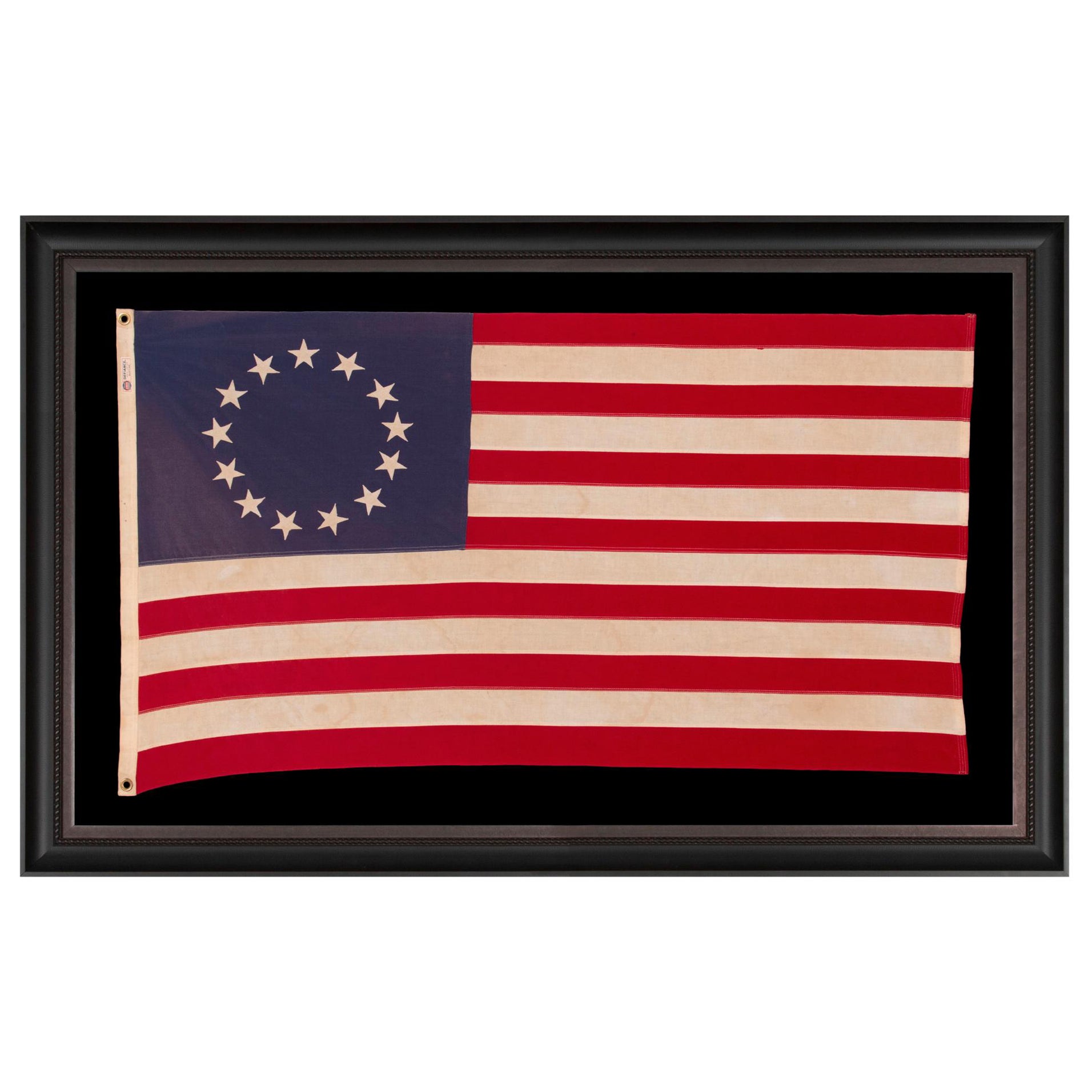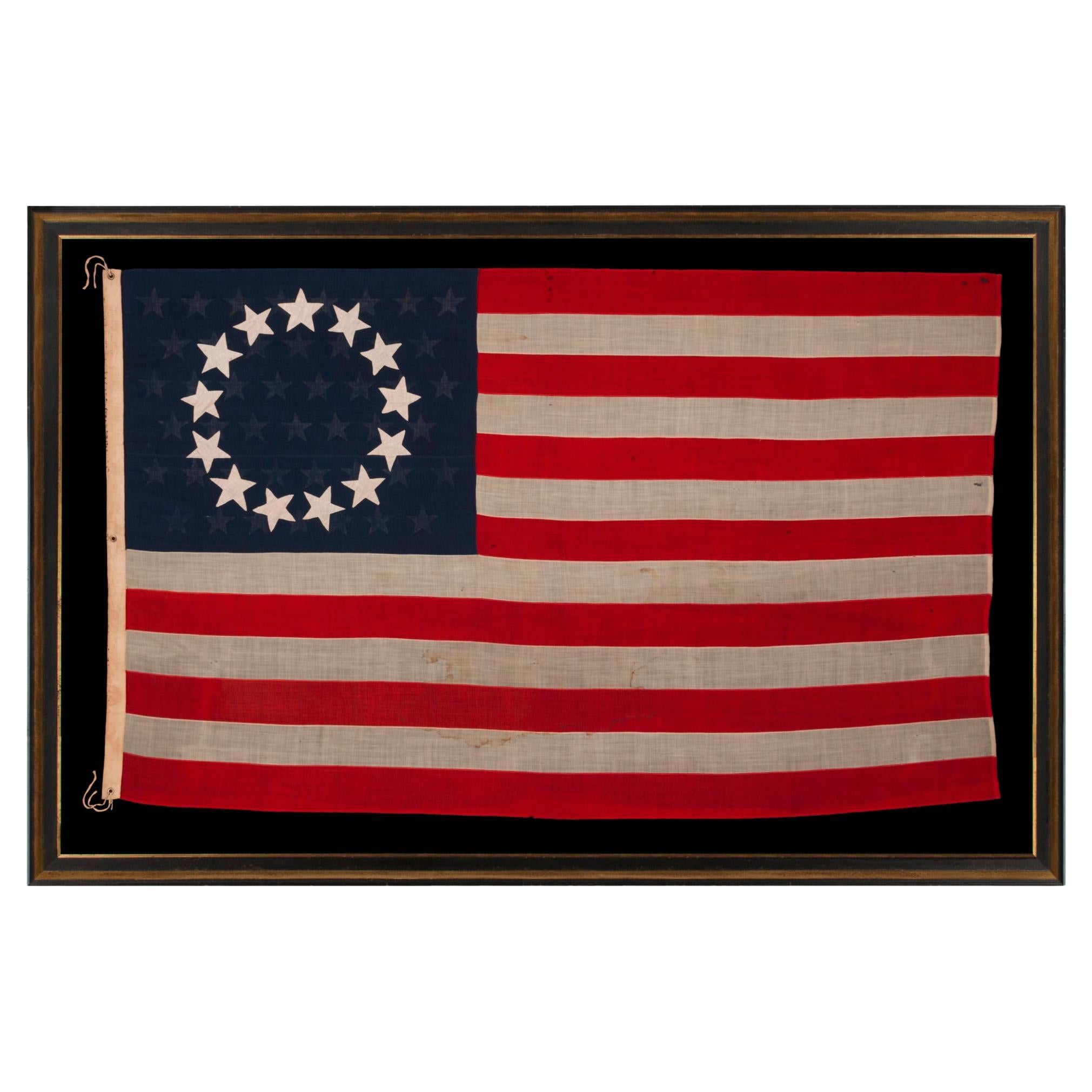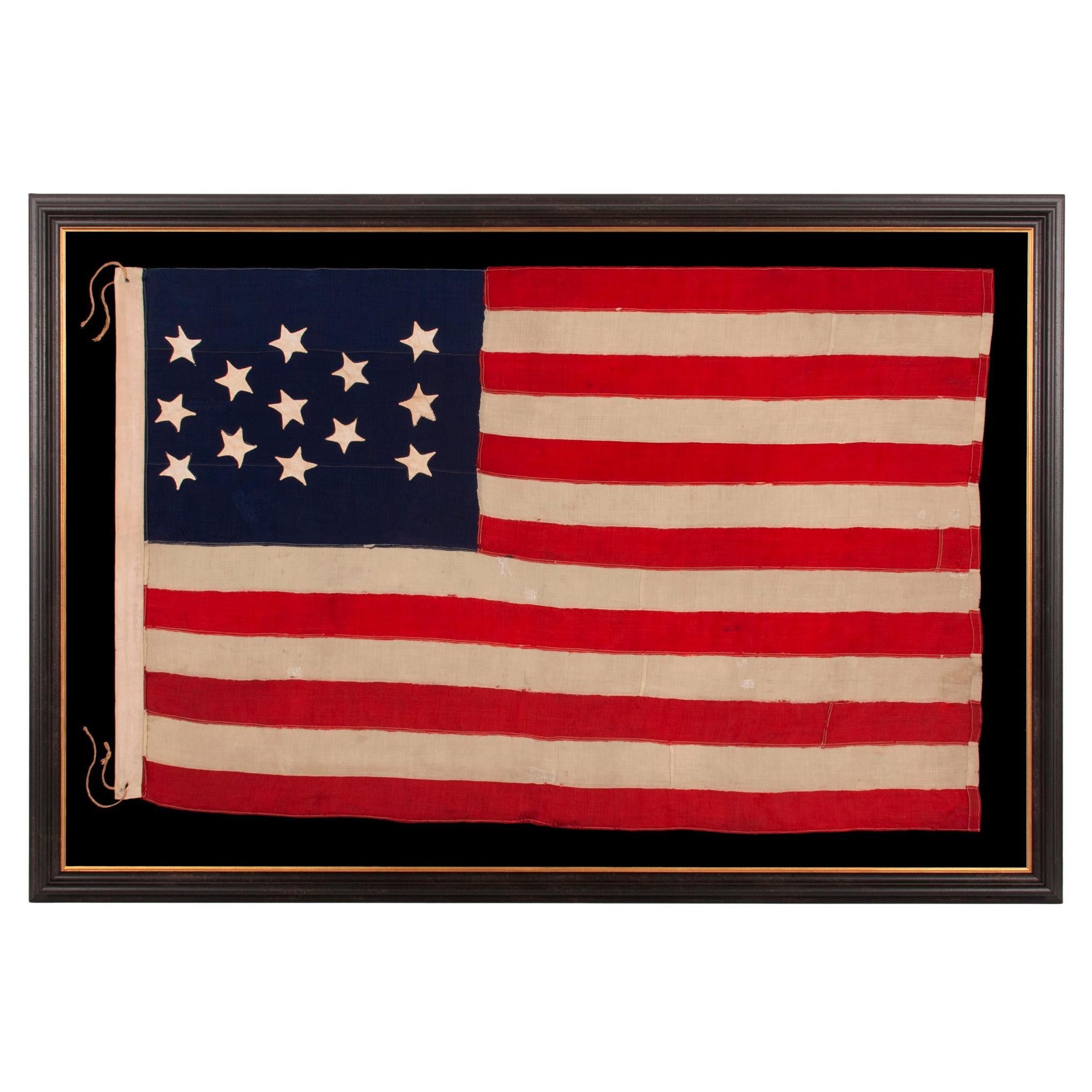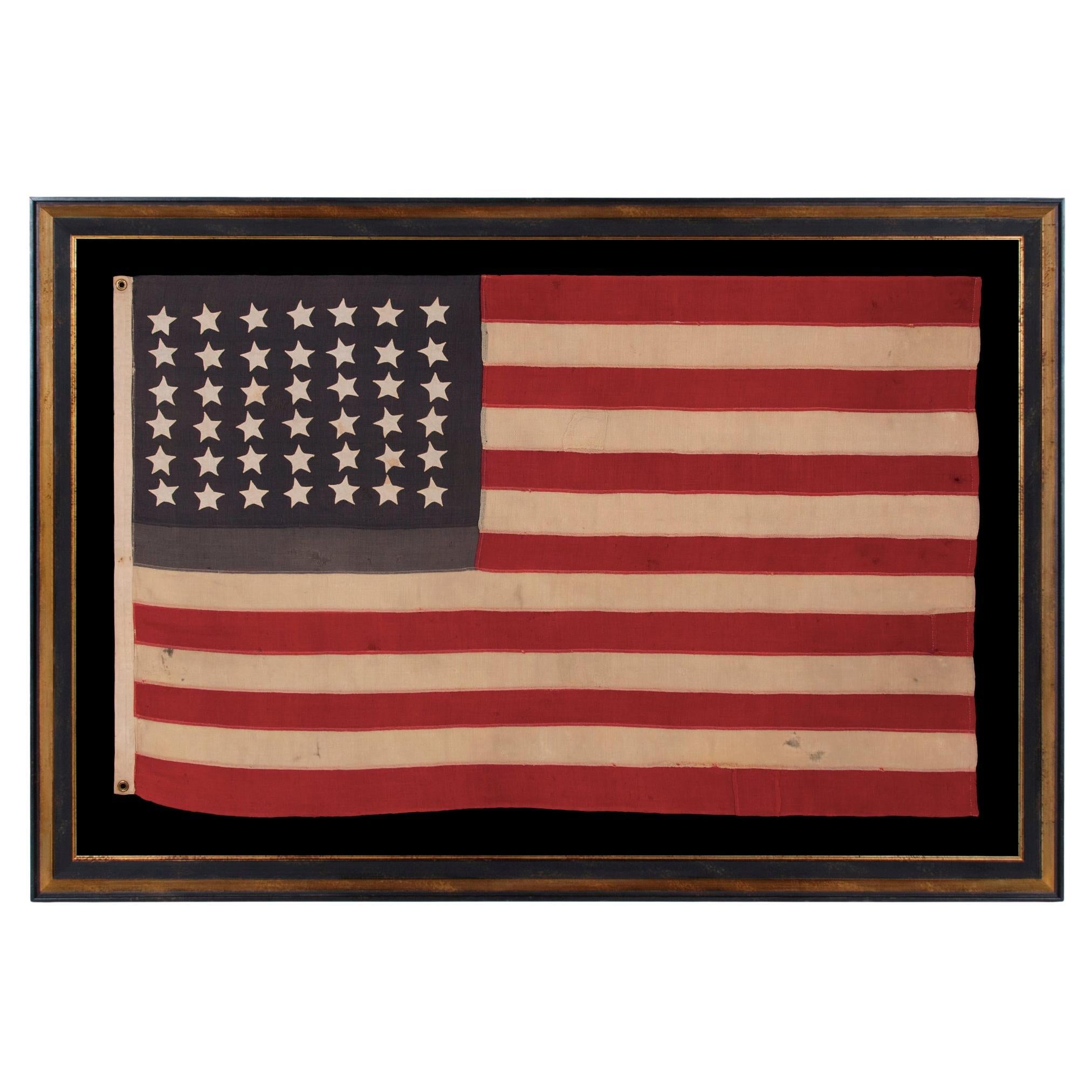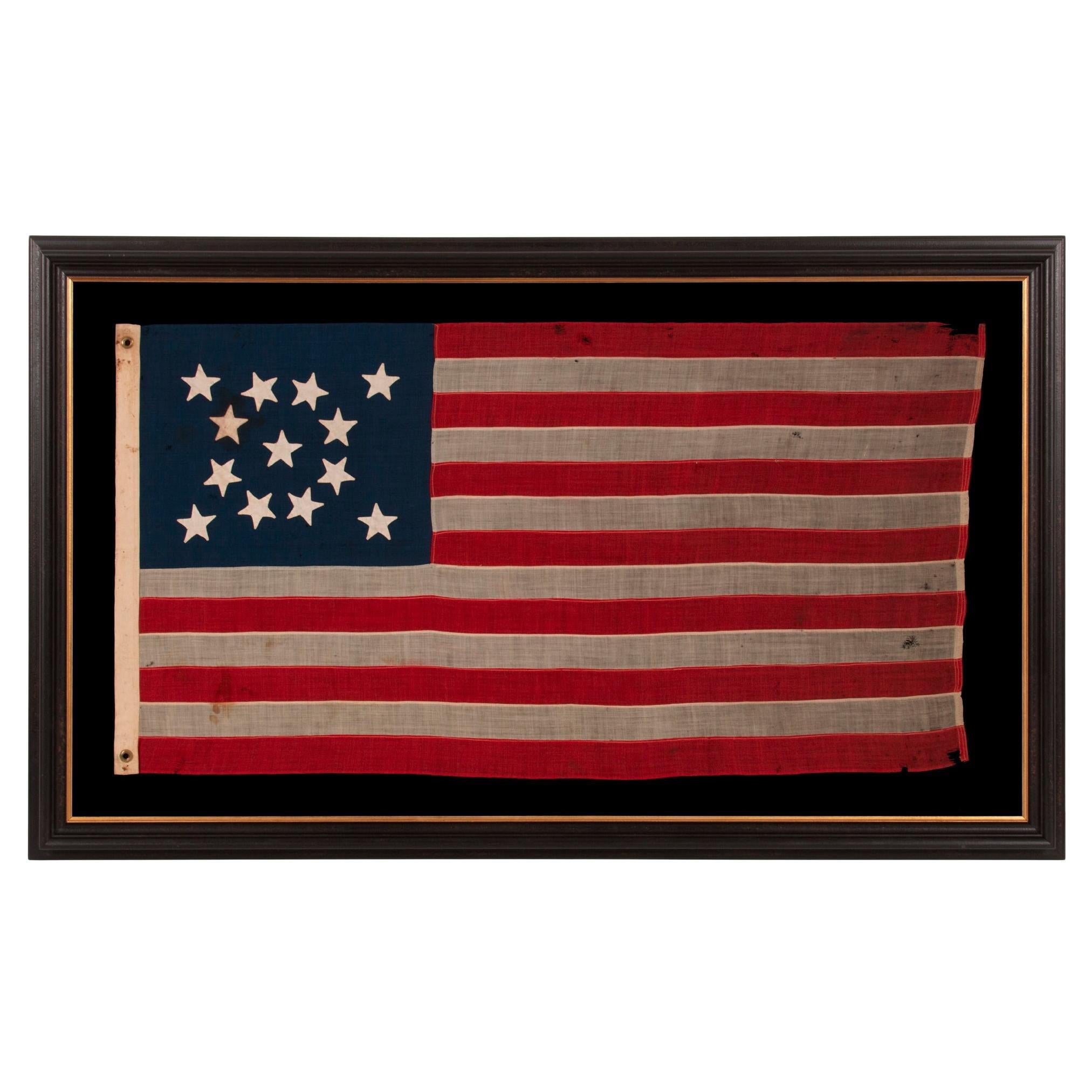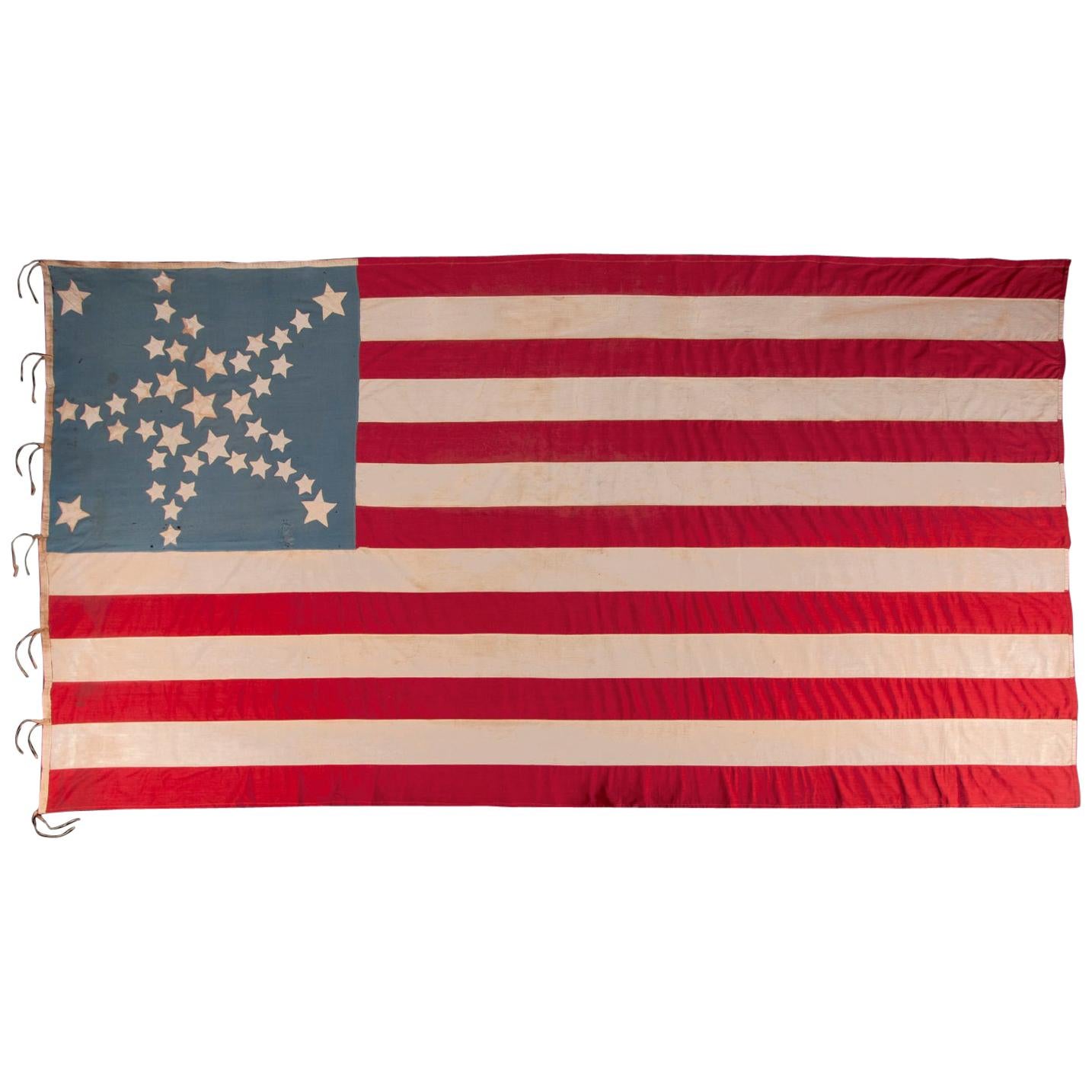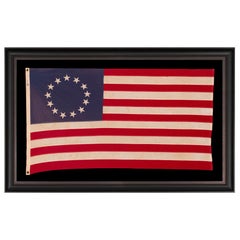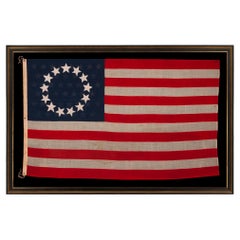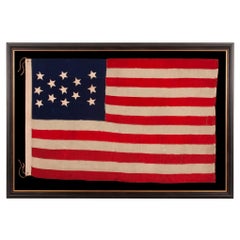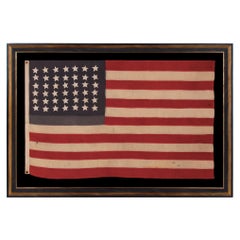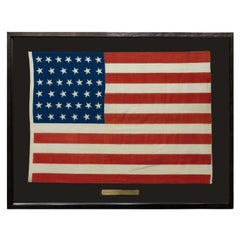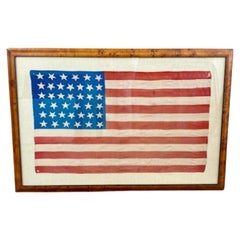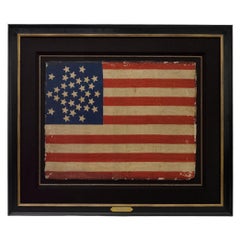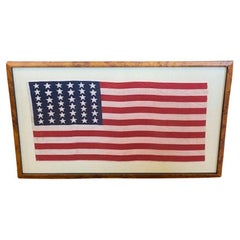Objekte ähnlich wie 13 Stars in a Betsy Ross Pattern, ca 1910-1926
Möchten Sie mehr Bilder oder Videos?
Zusätzliche Bilder oder Videos von dem*der Anbieter*in anfordern
1 von 7
13 Stars in a Betsy Ross Pattern, ca 1910-1926
Preis auf Anfrage
Angaben zum Objekt
13 STARS IN THE BETSY ROSS PATTERN ON A SMALL-SCALE ANTIQUE AMERICAN FLAG MADE SOMETIME BETWEEN APPROXIMATELY 1910 AND THE 1926 SESQUICENTENNIAL OF AMERICAN INDEPENDENCE
13 star flag of the type made from roughly the last decade of the 19th century through the first quarter of the 20th. The stars are arranged in the circular wreath pattern most often associated with Betsy Ross. Flags in this design are widely admired, due to the longstanding popularity of the Betsy Ross myth. While many Americans were taught in grammar school that this was what our first flag looked like, there is unfortunately no way to prove the claim. No colonial examples have survived with this pattern of stars. In fact, I have encountered just three surviving examples of Betsy Ross pattern flags that I believe to pre-date the 1890's.
Because there was no official star pattern for the American flag until 1912, just after New Mexico and Arizona entered the Union as the 47th and 48th states, the arrangement before that time was completely left to the liberties of the maker. As a result, there are more than 80 known star patterns for the 13 star count alone.
The canton and stripes of the flag are made of wool bunting that has been pieced with machine stitching. The stars are made of cotton and double-appliquéd (applied to both sides) with a zigzag machine stitch. There is a twill cotton binding along the hoist with three white metal grommets, along which “2 x 3” appears in a black-inked stencil, near the top, on the obverse, to indicate size in feet. Adjacent to this and perpendicular to it, the number “11” is inscribed in black, while “No. 11” appears on the reverse of the binding in teal blue grease pencil. Near the top, a penciled inscription, difficult to decipher, reads “Betsy Ross.” Together the elements of the flag’s construction point to the period between approximately 1910 and the 1926 Sesquicentennial of American Independence.
Why 13 Stars? As the number of stars grew with the addition of new states, it became more and more difficult to fit their full complement on a small flag. The stars would, by necessity, have to become smaller, which made it more and more difficult to view them from a distance as individual objects. The fear was that too many stars would appear as one white mass, at a distance and distort the ability to identify American ships on the open seas.
The U.S. Navy flew 13 star flags on small craft for precisely this reason. This was, of course, the original number of stars on the first American national flag, by way of the First Flag Act of 1777, and equal to the number of original colonies that became states. To the Navy, a small flag generally meant anything short of 10 feet. Prior to the 1890’s, the smallest sewn flags encountered with any regularity were approximately 6 feet on the fly. Because the primary use had long been more utilitarian than decorative, flags needed to be large to be effective as signals. Private use grew with the passage of time, however, as did worldwide ability to recognize the American flag, both of led to the production of flags of smaller scale.
In 1864, the newly released regulations for U.S. Navy small boat ensigns assigned each specified size with a numeric designation. In 1864 and 1870 regs, a No. 11 ensign measured 4.2 feet on the hoist by 8 feet on the fly. This size designation was removed until 1914, when it reappears with corresponding measurements of 2.37 x 4.5 feet. In neither instance does this correlate with the 2 x 3 foot specs of the Betsy Ross pattern flag that is the subject of this narrative. The Navy made its own flags at various locations, some of which were marked and dated. Because they sometimes acquired them simultaneously from commercial makers, ships’ chandlers and other sources, all of which appear to have loosely followed Navy specs in such instances—or else the Navy remained flexible, perhaps caring more about expediency and price, actual measurements varied greatly. This is hardly the only time that I have seen Navy designation on a flag stenciled with measurements that only loosely correspond.
Beginning around 1890, commercial flag-makers began to produce smaller flags for the first time in large quantities. These typically measured either 2 x 3 feet (like this example), or 2.5 x 4 feet. Applying the same logic as the Navy, they selected the 13 star count rather than the full complement of stars, for the sake of ease and visibility. Any flag that has previously been official remains so according to the flag acts, so even today 13 star flags remain official national flags of the United States of America.
One of the interesting misconceptions about 13 star flags is that an open, circular wreath pattern, even if not the original design, must have been common in early America. Logic would suggest this, given the frequency with which it appears in modern times. This was not the case, however; in fact, the pattern is seldom encountered anywhere until much later. Exceptions include a 1779-1780 painting of George Washington at the Battle of Princeton, by Charles Willson Peale, that depicts, in the background, a flag that appears to have a circular wreath of stars, but no stripes. This is one of the few appearances of a circular pattern in a work period to the Revolutionary War, yet it wasn’t the national flag and Peale may have used some artist’s liberty in its inclusion. While known to be especially detailed and keen on accuracy, Peale made at least four copies of the painting prior to 1782, one of which shows the Battle of Trenton in lieu of Princeton (the original), so he obviously wasn’t opposed to alterations. Trumbull, included a flag with what may be a circular pattern in a 1787 painting of the Battle of Yorktown, but the flag is waving and it is not known if the intended design was to be circular or oval.
Francis Hopkinson, credited designer of the Stars & Stripes, actually rendered a circular pattern of 13 eight-pointed stars, presented like the rowels of a spur, on a piece of 1778 Philadelphia currency. This did not show a flag and was not part of one. He included a similar rendering, surrounding a liberty cap, on a 1778 draft for the seal of the U.S. Board of War, but there is a flag affixed to the liberty pole on which the cap rests, and the flag, which displays only stars, arranges them in a 4-3-4-2 lineal pattern.
The only surviving 18th-century illustration of a 13 star, Stars & Stripes with a circular wreath and no center star, appears in a sketch by William Barton, which served as his 2nd draft for the Great Seal of the United States, presented to the 3rd Committee designated to select it. Though it does not survive, Barton’s first draft is also said to have included such a flag. The final draft was not rendered by Barton, but by Congressional Secretary Charles Thompson, who included no flags, but did include an arrangement of 13 stars above the head of a federal eagle, placed in a random pattern. It is of interest to note that Francis Hopkinson produced some of the initial drafts of the seal, which also included 13 stars in a random scatter (fig. 4).
One of the best arguments against the Betsy Ross pattern having appeared on the original flag is illustrated by the fact that so many 13 star flags exist without it. If the Ross design was the original, it stands to reason that the pattern would have been reproduced with at least some degree of frequency.
Research conducted by the National Museum of American History notes that the story of Betsy Ross making the very first American flag for General George Washington, in the company of George Ross and Robert Morris, entered into American consciousness about the time of the 1876 centennial. The tale was immensely popular among an American public eager for stories about the Revolution and its heroes. The first documentation of the narrative appeared shortly beforehand, in 1870, in a paper written by Betsy’s grandson, William Canby, for the Pennsylvania Historical Society. At the time Canby made no mention of how the flag was designed, save for the fact that it had 5-pointed stars, per his grandmother’s suggestion. Because no earlier documentation supports the story, most flag scholars feel it was a grand hoax, fabricated by Canby for his own interests. Nothing survives in the collective writings of the three men, for example, nor in records of their words and deeds, which are fairly extensive. As with most things, reality is perhaps somewhere in the middle ground, with some of the details based on fact and some on fiction, made up, misinterpreted, or imagined from family accounts.
The first time that a star configuration gets attached to the Ross story appears to have occurred during the last decade of the 19th century. In 1892, Charles Weisgerber painted a nine-by-twelve-foot rendition of the fabled meeting between Betsy and George Washington, in which there is a flag with a circular wreath. Shortly afterwards, in 1898, Betsy’s granddaughter and great-granddaughter began to make flags in the East Wing of Independence Hall in Philadelphia, selling them to tourists while disseminating family folklore. In that same year, Weisgerber and a “group of concerned citizens” sought to preserve Betsy’s former Philadelphia residence at 239 Arch Street, where she lived at the time the flag would have been sewed. Weisgerber moved his family into the house and immediately opened to the public the room in which Betsy was said to have worked her magic. Ten-cent memberships were sold to fund renovations and donors received a small calendar, to which a cotton 13 star Betsy Ross pattern parade flag was affixed. The effects of these events caused the Ross legend to stick and the story, with the corresponding flag design, has appeared ever since in more places than one could ever hope to count.
Mounting: For 25 years we have maintained our own textile conservation department, led by a master’s degree level graduate from one of the nation’s top university programs. We take great care in the mounting and preservation of flags and related textiles and have preserved thousands of examples.
The background is 100% cotton twill, black in color, that has been washed and treated for colorfastness. The black-painted, hand-gilded and distressed molding is Italian. The glazing is U.V. protective Plexiglas.
Condition: There is extremely minor spoiling along the hoist binding, but there are no significant condition issues.
Frame Size (H x L): Approx. 36" x 49"
Flag Size (H x L): 24" x 37"
- Maße:Höhe: 91,44 cm (36 in)Breite: 124,46 cm (49 in)Tiefe: 6,35 cm (2,5 in)
- Materialien und Methoden:
- Zeitalter:
- Herstellungsjahr:1910-1926
- Zustand:See Item Description.
- Anbieterstandort:York County, PA
- Referenznummer:Anbieter*in: 13j-17151stDibs: LU849745343272
Anbieterinformationen
5,0
Anerkannte Anbieter*innen
Diese renommierten Anbieter*innen sind führend in der Branche und repräsentieren die höchste Klasse in Sachen Qualität und Design.
Gründungsjahr 1991
1stDibs-Anbieter*in seit 2008
70 Verkäufe auf 1stDibs
Typische Antwortzeit: 1 bis 2 Tage
- VersandAngebot wird abgerufen …Versand von: York County, PA
- Rückgabebedingungen
Einige Inhalte dieser Seite wurden automatisch übersetzt. Daher kann 1stDibs nicht die Richtigkeit der Übersetzungen garantieren. Englisch ist die Standardsprache dieser Website.
Authentizitätsgarantie
Im unwahrscheinlichen Fall eines Problems mit der Echtheit eines Objekts kontaktieren Sie uns bitte innerhalb von 1 Jahr für eine volle Rückerstattung. DetailsGeld-Zurück-Garantie
Wenn Ihr Objekt nicht der Beschreibung entspricht, beim Transport beschädigt wurde oder nicht ankommt, kontaktieren Sie uns bitte innerhalb von 7 Tagen für eine vollständige Rückerstattung. DetailsStornierung innerhalb von 24 Stunden
Sie können Ihren Kauf jederzeit innerhalb von 24 Stunden stornieren, ohne jegliche Gründe dafür angeben zu müssen.Geprüfte Anbieter*innen
Unsere Anbieter*innen unterliegen strengen Dienstleistungs- und Qualitätsstandards, wodurch wir die Seriosität unserer Angebote gewährleisten können.Preisgarantie
Wenn Sie feststellen, dass ein*e Anbieter*in dasselbe Objekt anderswo zu einem niedrigeren Preis anbietet, werden wir den Preis entsprechend anpassen.Zuverlässige weltweite Lieferung
Unsere erstklassigen Versandunternehmen bieten spezielle Versandoptionen weltweit, einschließlich individueller Lieferung.Mehr von diesem*dieser Anbieter*in
Alle anzeigen13 Stern, Flagge mit Betsy Ross-Muster, hergestellt von der Annin Company, ca. 1955-1965
13 STERNE IM BETSY ROSS-MUSTER, AUF EINER ALTEN AMERIKANISCHEN FLAGGE, HERGESTELLT VON DER ANNIN COMPANY VON NEW YORK & NEW JERSEY, ca. 1955 - 1965
Amerikanische Nationalflagge mit ...
Kategorie
Ende des 20. Jahrhunderts, amerikanisch, Politische und patriotische Eri...
Materialien
Baumwolle
Antike amerikanische Flagge mit 13 Sternen im Betsy Ross-Design und 45 Sternen auf der Rückseite
13 STERNE IM BETSY-ROSS-MUSTER, MIT 45 STERNEN AUF DER RÜCKSEITE; AUF EINER ALTEN AMERIKANISCHEN FLAGE, HERGESTELLT UND UNTERSCHRIFTEN VON EINER VORHER UNBEKANNTEN FLAGENMACHERIN, A...
Kategorie
Antik, 1890er, amerikanisch, Sonstiges, Politische und patriotische Erin...
Materialien
Wolle, Baumwolle
13 Sterne Antike amerikanische Flagge mit einem schmalen Stern Präsentation, ca. 1876
ANTIKE AMERIKANISCHE FLAGGE MIT 13 STERNEN, HANDGENÄHT IN EINER EXTREM SCHMALEN 3-2-3-2-3-ANORDNUNG AUF EINEM KANTON, DER SICH NICHT AN DIESE ANORDNUNG HÄLT UND OBEN UND UNTEN WEITE ...
Kategorie
Antik, 1870er, amerikanisch, Politische und patriotische Erinnerungsstücke
Materialien
Wolle
42 handgenähte Sterne auf einer antiken amerikanischen Flagge ca. 1889-1890
42 HANDGENÄHTE STERNE AUF EINER ALTEN AMERIKANISCHEN FLAGE MIT ZWEIFARBIGEM, STAUBBLAUEM KANON, DARSTELLT DEN ZUSATZ VON WASHINGTON STATE, MONTANA UND DEN DAKOTAS, NIE EINE OFFIZIELL...
Kategorie
Antik, Spätes 19. Jahrhundert, amerikanisch, Politische und patriotische...
Materialien
Wolle
13 Stern Antike amerikanische Flagge , handgenähte Sterne in einem Medaillon, 1876 Hundertjahrfeier
ANTIKE AMERIKANISCHE FLAGGE MIT 13 STERNEN UND EINEM MEDAILLON AUS HANDGENÄHTEN STERNEN UND EINEM SCHÖNEN, LÄNGLICHEN PROFIL, AUS DER ZEIT DER HUNDERTJAHRFEIER DER AMERIKANISCHEN UNA...
Kategorie
Antik, 1870er, Politische und patriotische Erinnerungsstücke
Materialien
Wolle
34-Sterne-Flagge der amerikanischen Flagge, aktualisiert auf 39 Sterne, mit Sternen in einem Großsternmuster
34 STERNE IN EINER SKURRILEN WIEDERGABE DES GROSSEN STERNENMUSTERS AUF EINER FLAGGE AUS DER BÜRGERKRIEGSZEIT MIT KORNBLUMENBLAUEM KANTON, 1876 AUF 39 STERNE AKTUALISIERT
Amerikanisc...
Kategorie
Antik, 1870er, amerikanisch, Politische und patriotische Erinnerungsstücke
Materialien
Baumwolle
Preis auf Anfrage
Kostenloser Versand
Das könnte Ihnen auch gefallen
Antike amerikanische Flagge mit 39-Stern-Muster und skurrilem Sternmuster, 1889
Dies ist eine inoffizielle amerikanische Flagge mit 39 Sternen, handgefertigt und auf Baumwolle gedruckt. Die Flagge stammt aus dem Jahr 1889 und hat dank ihrer seltenen Sternenzahl ...
Kategorie
Antik, 1880er, amerikanisch, Politische und patriotische Erinnerungsstücke
Materialien
Baumwolle
Amerikanische 39-Sterne-Flagge aus dem 19. Jahrhundert, ca. 1889
Amerikanische 39-Sterne-Flagge des 19. Jahrhunderts, um 1889, eine Paradeflagge aus bedruckter Seide mit einem Wellenmuster aus tanzenden Sternen. Diese Flagge war nie eine offiziell...
Kategorie
Antik, 1880er, amerikanisch, Federal, Politische und patriotische Erinne...
Materialien
Seide
31-Sterne-gedruckte amerikanische Flagge, zum Gedenken an die Staatlichkeit Kaliforniens, um 1850
Dies ist eine seltene, mit 31 Sternen bedruckte amerikanische Flagge, mit der die Aufnahme Kaliforniens in die Union gefeiert wird. Die Flagge ist auf Seide gedruckt und hat ein spek...
Kategorie
Antik, 1850er, amerikanisch, Politische und patriotische Erinnerungsstücke
Materialien
Seide
Amerikanische Flagge mit 39 Sternen, 19. Jahrhundert, um 1889
Amerikanische Flagge mit 39 Sternen, 19. Jahrhundert, um 1889, bedruckte Leinenflagge mit 39 Sternen in einem wellenförmigen Sternmuster und Streifen in einer sehr ungewöhnlichen län...
Kategorie
Antik, 1880er, amerikanisch, Federal, Politische und patriotische Erinne...
Materialien
Leinen
Amerikanische Flagge mit 45 Sternen, gedruckt auf Baumwolle, zur Feier der Staatlichkeit Utahs, 1896-1908
Diese 45-Sterne-Flagge der Vereinigten Staaten feiert die Staatsgründung von Utah. 45-Sterne-Flaggen dienten von 1896 bis 1908 als offizielle amerikanische Flagge. Diese besondere Fl...
Kategorie
Antik, 1890er, amerikanisch, Politische und patriotische Erinnerungsstücke
Materialien
Baumwolle
48-Sterne bedruckte amerikanische Flagge, die Staatsgründung Arizonas gewürdigt, 1912-1958
Dies ist eine originale amerikanische Paradeflagge mit 48 Sternen zur Feier der Staatsgründung von Arizona. Diese Flagge, ein wunderbares Produkt der frühen Geschichte unserer Nation...
Kategorie
Mitte des 20. Jahrhunderts, amerikanisch, Politische und patriotische Er...
Materialien
Stoff
